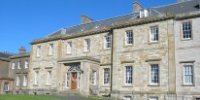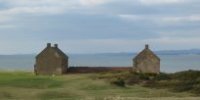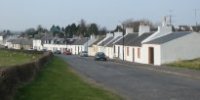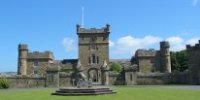 |
 |
 |
 |
Research Postings |
 |
Copyright notice: Links to this site are welcomed. However none of the material on the site may be duplicated in any form. The copyright of the articles is the property of the authors. Copyright of the web pages is the property of David McClure. |
Ballochmyle House and Hospital
From Mary Fisher, 10 Feb 05: My father was stationed at Prestwick Air Force Base from 1954-1956. Both of my parents and I have found some old 'get wel'l cards that were addressed to my mother from June of 1955. They are addressed to Ballochmyle Hospital, J.B. Ferguson Ward. Can you help me with what kind of hospital this was and what was the J.B. Ferguson Ward? I am trying to track my family history and am just curious about this unexplained hospital stay. From Gayle Turner, 21 Feb 05: I am currently reaserching the history of Ballochmyle house so far there isn't very much information, it sort of stops, if anyone could help it would be much appriciated. I would like to hear stories see pictures and soon before it is totaly torn to shreds. From David Gibson, 29 Mar 05: Ballochmyle Hospital was built at the beginning of the second world war. I supervised the demolition of it in 2001, however some of the remains are still on site. It was built as an A&E hospital but was later used as a burns unit for service personnel.The mansion house which dominated the site is where Robert Burns met The Bonny Lass of Ballochmyle and is presently being reconsructed to luxury flats. Photographs of the hospital during the war are available on the Mauchline Web site. From David Thom, 18 June 05: 'Ballochmyle' was one of about 8 'Emergency Medical Services' hospitals constructed at the outbreak of WW2. They were intended to treat casualties from possible bombing raids on nearby Towns & Cities, with the supposition that the respective Town & City Hospitals could also be victims of any aerial blitz. The expected massive civilian casualties did not materialise and these Emergency Medical Service (EMS) hospitals were quickly adopted as military hospitals, receiving wounded servicemen from a widespread theatre of war. [It is fair to say that most of them also treated members of the civilian population when this was called for). They also treated servicemen (and women) for lesser emergencies (appendicitis) & 'routine' procedures (hernia repair). They were all built to a similar standard Government pattern, single story brick & timber 'huts' joined by open spine corridors, laid out in units within the site, to minimise the spread of fire. Roofing varied and both corrugated iron & corrugated asbestos sheeting was used; also, some of the walls were of asbestos sheeting. Designed (and built) to last for 10 years, these hospitals were taken over by the National Health Service in 1948 and continued in use (as civilian hospitals) for another 30 to 40 years! Apart from Ballochmyle Hospital, the others were : Peel Hospital (Galashiels), Bangour Hospital (West Lothian), Killearn Hospital (Dumbartonshire), Bridge of Earn Hospital (Perth & Kinross), & Raigmore Hospital (Inverness), [I'm uncertain about Aberdeen]. Ballochmyle specialised in Burns & Plastic Surgery, and the associated Maxillo-facial surgery, as did Bangour, & Bridge of Earn. Killearn & Bangour specialised in Neuro-surgery. These war-time necessities were continued after the cessation of hostilities and the main centres now operating in Glasgow, West Lothian, & Dundee can trace their roots back to these old EMS hospitals. The world renowned Plastic Surgeons Sir Harold Gillies & Sir Archibald McIndoe visited these centres on a regular basis and taught & instructed the 'drafted-in' surgeons (many of them local) the principles of plastic surgery. Each visit continued enhancing their skill & knowledge and most became, very soon, competent plastic surgeons. The staff in these units had a fierce pride in their hospitals & work and many long lasting friendships were struck between staff & patients. Sadly, the pride went when these units closed and the modern replacements never felt the same to work in. Hope this is of interest, D. Thom. [I worked (post-war) in the Burns, Plastic Surgery & Maxillo-facial unit at Bangour Hospital, until its closure & removal to a modern centre.] From Mary Gallacher, 10 April 2006: I'm looking for pictures of Ballochmyle Hospital. It's dear to my heart because I trained to become a nurse in the early sixties and will retire with memories of my first love of Ayrshire. From David McClure: See Ayrshire & Arran: an illustrated historical guide by Rob Close (RIAS, 1992), 149.
|